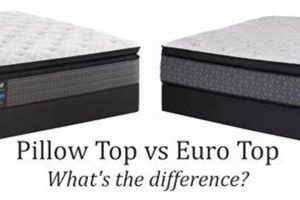The comparison involves two standard sizes of mattresses, differentiated primarily by their dimensions. One option provides a sleeping surface measuring approximately 54 inches wide by 75 inches long, while the other offers a larger area of about 60 inches wide by 80 inches long. These measurements determine the amount of space available for sleepers.
The consideration between these sizes is vital for individuals and couples seeking optimal sleep comfort within the constraints of available bedroom space and budget. Historically, choices were limited, but contemporary consumers benefit from a variety of options tailored to specific needs and preferences. The decision influences sleep quality, partner disturbance, and the overall aesthetics of the bedroom environment.
The following sections will delve into the specific factors that differentiate these mattress sizes, including dimensions, suitability for different sleepers, cost implications, and bedroom compatibility. These factors should inform a considered decision when selecting the appropriate mattress.
Guidance for Size Selection
Selecting the appropriate mattress size is crucial for ensuring optimal sleep quality and comfort. Consider the following guidelines when evaluating options.
Tip 1: Assess Available Space: Measure the dimensions of the intended bedroom. Ensure sufficient clearance for movement and other furniture after the mattress is in place.
Tip 2: Evaluate Sleeper Size and Number: A single sleeper may find the smaller option adequate, while couples generally benefit from the increased space provided by the larger size. Individual body size also factors into the decision.
Tip 3: Consider Sleep Style: Individuals who toss and turn frequently during sleep may require the additional width offered by the larger mattress.
Tip 4: Analyze Budget Constraints: The smaller option typically presents a lower initial cost. Factor in long-term value and potential impact on sleep quality when making financial decisions.
Tip 5: Anticipate Future Needs: Consider potential changes in living arrangements or sleeping partners when selecting a mattress size. A larger size offers greater flexibility over time.
Tip 6: Review Frame and Bedding Compatibility: Ensure existing or planned bed frames and bedding accessories are compatible with the chosen mattress dimensions. Incompatible items may require additional expenditure.
Careful consideration of these factors will lead to a more informed decision, resulting in improved sleep quality and overall satisfaction with the selected mattress.
The subsequent sections will provide a comparative analysis of specific brands and models within these size categories.
1. Surface Area
Surface area constitutes a primary differentiating factor between mattress sizes. The larger option provides significantly more sleeping surface. This increased area directly impacts comfort levels, particularly for couples or individuals who move considerably during sleep. A larger surface reduces the likelihood of disturbing a sleeping partner due to movement, thereby contributing to improved sleep quality for both individuals.
For example, a couple accustomed to sleeping on the smaller mattress may experience frequent disturbances throughout the night as they inadvertently encroach upon each other’s space. Upgrading to the larger size can alleviate this issue by providing each person with more individual room. Conversely, a single sleeper with limited bedroom space may find the smaller mattress sufficient, without sacrificing excessive floor area.
Ultimately, the correlation between surface area and mattress choice is one of space management and comfort optimization. Selecting a mattress with adequate surface area relative to the sleeper(s) and available bedroom space is essential for maximizing sleep quality and overall satisfaction with the purchase. The impact on sleep quality and partner disturbance can significantly affect daily well-being.
2. Bedroom Size
Bedroom size directly dictates the suitability of a mattress. Choosing a mattress that overwhelms the room impairs movement and diminishes the overall comfort of the space. Conversely, a mattress that is disproportionately small can render the room aesthetically unbalanced. Therefore, careful consideration of room dimensions is paramount before selecting either option. A larger room typically accommodates the larger mattress without sacrificing usable space, while a smaller room may necessitate the selection of a smaller option to maintain functionality.
For instance, a bedroom measuring 10 feet by 10 feet would likely feel cramped with the larger mattress, leaving minimal space for bedside tables or walking around. In contrast, a bedroom measuring 12 feet by 14 feet could easily accommodate it, providing a more spacious and comfortable environment. The practical significance lies in ensuring that the mattress complements the room’s proportions, promoting a sense of balance and ease of movement. Failure to adequately assess the space leads to a compromised living experience, affecting both sleep quality and the overall ambiance of the bedroom.
In summary, the interplay between bedroom size and mattress selection is crucial for optimizing both functionality and aesthetics. Prioritizing accurate measurements and understanding the impact of mattress dimensions on the overall room dynamic will contribute to a more comfortable and harmonious living space. The challenge lies in finding the balance that accommodates sleep needs without overwhelming the room’s physical dimensions, ultimately enhancing the quality of life within the bedroom environment.
3. Sleeper Occupancy
Sleeper occupancy, whether single or double, exerts a considerable influence on the appropriate mattress size. The smaller size, while suitable for individual sleepers, often proves inadequate for couples. The restricted surface area can lead to discomfort, disrupted sleep, and heightened awareness of a partner’s movements. This contrasts sharply with the larger option, which offers greater individual space for each occupant, promoting undisturbed rest. The number of sleepers directly dictates the minimum acceptable mattress dimensions for ensuring adequate comfort. For example, a single adult might experience ample space on the smaller size, while a couple sharing this same mattress may find themselves cramped and experiencing frequent awakenings due to proximity and movement.
Furthermore, the comfort needs are determined by the individual sleepers’ sizes. Two smaller adults may find the smaller size adequate, while two larger adults will find that the larger mattress size, and potentially even larger sizes, such as king, are better suited. This demonstrates the correlation that couples or larger sleepers are more likely to benefit from the increased area. This additional space can mitigate the negative effects of tossing and turning, minimizing partner disturbance. The choice then becomes not simply about the number of occupants, but also about their individual needs and the potential impact on their collective sleep quality. The difference reflects a practical consideration for long-term sleep health and relationship harmony, factors often overlooked in the initial purchase.
In conclusion, a careful assessment of sleeper occupancy and individual sleeper sizes is essential when choosing between sizes. Single sleepers may find the smaller option sufficient, but couples generally benefit from the increased surface area, which promotes less interrupted sleep and a more comfortable rest. Neglecting this assessment can lead to chronic sleep deprivation, impacting overall well-being and highlighting the critical importance of aligning mattress dimensions with the number and sizes of intended sleepers to ensure sleep quality.
4. Cost Differential
The acquisition cost presents a key difference between mattress sizes. A smaller mattress typically exhibits a lower price point than its larger counterpart. This differential arises from several factors, including the quantity of materials used in construction, manufacturing processes, and transportation logistics. As the dimensions increase, the resource requirements and associated expenses escalate, resulting in a higher retail price. This cost differential has a direct impact on consumer purchasing decisions, particularly for budget-conscious individuals or those with limited financial resources. For example, a student furnishing a first apartment might prioritize the lower cost of the smaller mattress, even if the larger size would offer greater comfort. Understanding the cost implications is a crucial component of evaluating the value proposition.
The cost differential extends beyond the initial purchase price. Associated expenses, such as bed frames, bedding, and shipping fees, often vary depending on the mattress size. Larger mattresses typically require more substantial bed frames, which can further contribute to the overall cost. Similarly, specialized bedding, such as sheets and comforters, may be more expensive for the larger size due to the increased fabric requirements. Therefore, a comprehensive cost analysis should consider not only the mattress itself, but also these ancillary expenses. A practical application involves comparing the total cost of ownership, including these associated expenses, to determine the most economically viable option over the long term. Ignoring these additional expenses can lead to inaccurate budget assessments and potentially regretful purchasing decisions.
In summary, the cost differential between these mattresses reflects a complex interplay of material costs, manufacturing processes, and logistical considerations. This cost impacts consumer decisions and extends beyond the initial purchase price to include associated expenses. A thorough evaluation of the total cost of ownership is essential for making informed purchasing decisions. This ensures that the selected mattress aligns with budgetary constraints without compromising long-term comfort and value. Recognizing and addressing the cost differential allows consumers to make a more rational and financially responsible choice.
5. Accessory Availability
Accessory availability represents a practical consideration when differentiating between mattresses. While both mattress sizes enjoy widespread market support, subtle variations exist in the breadth and variety of available accessories.
- Bedding Options
Sheets, comforters, and mattress protectors are universally available for both sizes. However, specialty bedding, such as organic cotton or luxury thread counts, might exhibit a greater selection within popular size. Consumers seeking highly specific materials or designs may find more choices available for the most common size mattress. The practical outcome is streamlined purchasing for widely adopted dimensions.
- Frame Compatibility
Bed frames are manufactured to accommodate standardized mattress dimensions. A wide array of frame styles, from platform beds to adjustable bases, exists for each size. Nevertheless, vintage or antique bed frames might be predominantly designed for the smaller size, requiring modifications or custom solutions to accommodate the larger size. This demonstrates the importance of considering frame compatibility during the purchasing process.
- Mattress Toppers
Mattress toppers, designed to enhance comfort or prolong mattress life, are readily available in both dimensions. However, less common materials or unique construction methods may initially be more available within the common mattress size market due to higher demand and faster product cycling. Over time, specialized topper options typically expand to include more mattress sizes, reflecting shifting consumer preferences.
- Specialty Pillows
While not directly tied to mattress size, the choice of mattress impacts pillow selection. Individuals selecting the larger mattress, particularly couples, often opt for multiple pillows or larger pillow sizes to adequately fill the sleeping surface. Therefore, while the availability of pillow types does not differ significantly, the quantity required and the overall aesthetics of the bed are influenced by the choice of mattress.
Accessory availability, while generally equitable, presents nuanced differences. Consumers with highly specific requirements may find greater initial selection or potentially lower prices among accessories designed for the more common mattress size. However, the overall market ensures that both mattress sizes enjoy a robust selection of bedding, frames, and complementary accessories. Considering these subtle variations is essential for a comprehensive purchasing decision.
Frequently Asked Questions
The following questions address common concerns and misconceptions regarding the selection of mattress dimensions. The information provided aims to clarify key considerations for prospective buyers.
Question 1: Is a larger mattress always preferable?
A larger mattress is not invariably the superior choice. The optimal size depends on bedroom dimensions, sleeper occupancy, and individual preferences. Prioritizing a larger mattress without considering these factors may result in a cramped bedroom or unnecessary expense.
Question 2: Does the cost difference solely reflect material quantity?
The cost difference extends beyond material quantity. Factors such as manufacturing complexity, shipping expenses, and retailer pricing strategies also contribute to the price disparity. A comprehensive cost analysis should account for all related expenses.
Question 3: Are bedding options equally diverse for both sizes?
While a broad selection exists for both sizes, subtle variations may occur in the availability of niche or specialty bedding items. Consumers seeking highly specific materials or designs may encounter a more limited selection for one size compared to the other.
Question 4: Does mattress size directly correlate with sleep quality?
Mattress size influences sleep quality indirectly. Increased surface area can minimize partner disturbance and allow for greater freedom of movement, thereby promoting more restful sleep. However, factors such as mattress firmness, material composition, and individual sleep habits also play significant roles.
Question 5: Is the smaller mattress sufficient for single sleepers?
The adequacy of the smaller mattress for single sleepers depends on individual body size and sleep preferences. Individuals who are taller or who prefer to stretch out during sleep may find the smaller mattress restrictive, while others may find it perfectly adequate.
Question 6: Should future needs be considered when selecting a mattress size?
Anticipating future changes in living arrangements or relationship status is prudent. Selecting a larger mattress provides greater flexibility and accommodates potential increases in sleeper occupancy, offering a long-term advantage over a size that may become inadequate.
In summary, selecting the appropriate mattress dimensions involves a multifaceted assessment of individual needs, budgetary constraints, and spatial considerations. Careful evaluation of these factors will result in a more informed purchasing decision.
The subsequent section will explore specific brand and model comparisons within these mattress size categories.
Conclusion
This exploration of mattress sizes aimed to provide clarity and actionable insights. The key differences relate to surface area, spatial compatibility, sleeper occupancy, and cost considerations. There is no universally superior choice; rather, the ideal mattress is contingent on a careful evaluation of individual requirements and constraints. Understanding the nuances of each size empowers informed decision-making.
The selection of a mattress represents a significant investment in sleep quality and overall well-being. Prioritizing a balanced assessment of practical needs and financial resources will lead to a more satisfying and beneficial outcome. Future advancements in sleep technology may offer new solutions, but the fundamental principles of size suitability will remain critical for optimizing the sleep experience. The user is encouraged to apply this knowledge thoughtfully.







